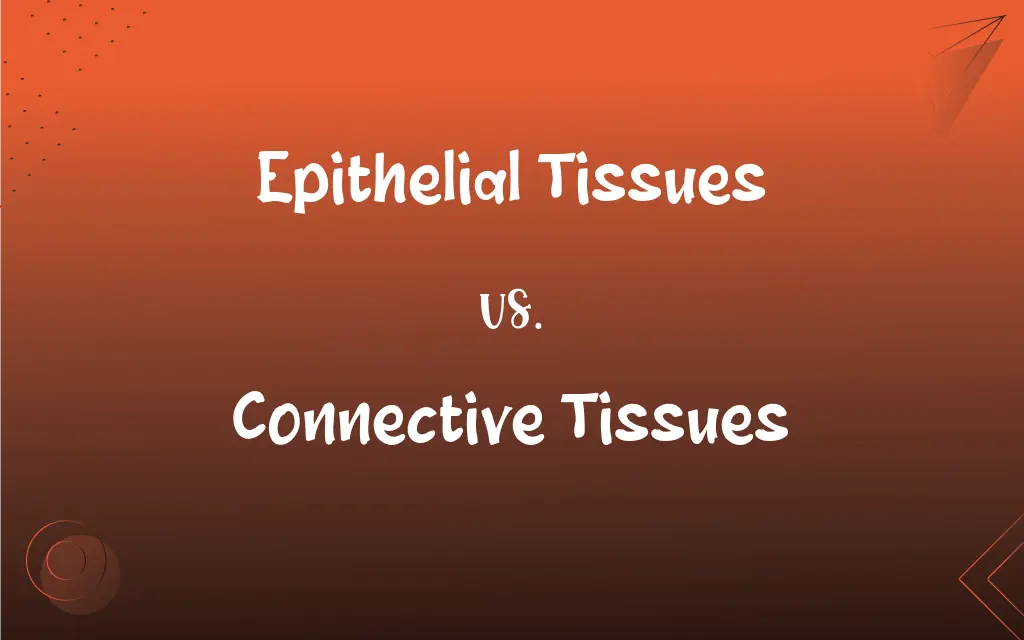Epithelial Tissues vs. Connective Tissues: What's the Difference?
Edited by Janet White || By Harlon Moss || Updated on October 28, 2023
Epithelial tissues form protective barriers and line organs, while connective tissues support, bind, and protect structures in the body.

Key Differences
Epithelial tissues are sheets of tightly packed cells covering external surfaces and lining internal cavities and organs. They act as barriers, control permeability, and may have secretory functions. Connective tissues, on the other hand, provide support and structure, connecting and binding different parts of the body. They include diverse types like bone, cartilage, and blood.
Epithelial tissues are characterized by minimal extracellular matrix, often forming the body's first defense against physical, chemical, and biological wear and tear. In contrast, connective tissues are rich in extracellular matrix, which provides the tissue with strength and flexibility. This matrix contains various fibers and ground substances that determine the tissue's properties.
The cells in epithelial tissues are closely packed with little intercellular space and are often arranged in sheets or layers. Connective tissues have fewer cells that are more spread out, embedded in a large amount of extracellular matrix, which may be fluid, gel-like, or solid.
Epithelial tissues have a high capacity for renewal and regeneration due to their location in areas of frequent wear and tear. In contrast, connective tissues have variable regenerative abilities; some like bone regenerate well, while others like cartilage have limited repair capacity.
Epithelial tissues have a wide range of functions including protection, absorption, filtration, excretion, secretion, and sensory reception. Connective tissues have functions ranging from providing structural support, storing energy, and protecting organs, to facilitating immune responses and repairing damaged tissues.
ADVERTISEMENT
Comparison Chart
Function
Protection, absorption, secretion
Support, binding, protection
Cell Arrangement
Tightly packed, minimal extracellular matrix
Sparsely distributed cells, abundant extracellular matrix
Location
Covers body surfaces, lines cavities
Throughout the body, connecting structures
Regeneration
High regenerative capacity
Variable, depending on type
Examples
Skin, lining of digestive tract
Bone, cartilage, blood, adipose tissue
ADVERTISEMENT
Epithelial Tissues and Connective Tissues Definitions
Epithelial Tissues
Epithelial tissues can have secretory functions in glands.
Salivary glands consist of epithelial tissues that produce saliva.
Connective Tissues
Connective tissues include diverse types like bone, cartilage, and blood.
Blood, a fluid connective tissue, transports nutrients and oxygen.
Epithelial Tissues
Epithelial tissues line internal organs and cavities.
The lining of the stomach, made of epithelial tissues, helps in digestion.
Connective Tissues
Connective tissues are involved in protection and insulation.
Adipose tissue, a connective tissue, stores fat and insulates the body.
Epithelial Tissues
Epithelial tissues are avascular but innervated.
Despite lacking blood vessels, epithelial tissues in the skin have nerve endings.
Connective Tissues
Connective tissues provide structural support in the body.
Bone, a type of connective tissue, gives the body its framework.
Epithelial Tissues
Epithelial tissues form protective layers on body surfaces.
The skin is composed of epithelial tissues that protect against external harm.
Connective Tissues
Connective tissues connect different structures together.
Tendons, as connective tissues, attach muscles to bones.
Epithelial Tissues
Epithelial tissues are characterized by tight cell junctions.
The tightly packed cells in epithelial tissues prevent leakage in the bladder.
Connective Tissues
Connective tissues have an abundant extracellular matrix.
The matrix in connective tissues like cartilage provides cushioning in joints.
FAQs
What is the significance of tight junctions in epithelial tissues?
Tight junctions prevent leakage and maintain selective barriers.
What are epithelial tissues?
Epithelial tissues are layers of cells covering body surfaces and lining internal cavities.
How are epithelial tissues different from connective tissues?
Epithelial tissues are tightly packed cell layers with minimal matrix, while connective tissues have fewer cells in an abundant matrix.
What are examples of epithelial tissues?
Skin, lining of the stomach, and glandular tissues.
What are examples of connective tissues?
Bone, cartilage, tendons, blood, and adipose tissue.
What are connective tissues?
Connective tissues are diverse tissues providing support, binding, and protection in the body.
Can epithelial tissues regenerate?
Yes, they have a high capacity for renewal and regeneration.
Where are connective tissues located?
Connective tissues are distributed throughout the body, in bones, tendons, blood, and more.
What is the main function of epithelial tissues?
The main function is to protect, secrete, absorb, and act as a barrier.
Can connective tissues regenerate?
Their regenerative ability varies; some like bone regenerate well, others less so.
Where are epithelial tissues located?
Epithelial tissues are found on skin, internal organ linings, and glandular tissues.
Do epithelial tissues have blood vessels?
No, epithelial tissues are avascular but innervated.
Do connective tissues have blood vessels?
Yes, most connective tissues are vascularized.
Are epithelial tissues involved in absorption?
Yes, certain epithelial tissues like in the intestine are involved in absorption.
Can epithelial tissues form glands?
Yes, some epithelial tissues form glands for secretion.
What roles do connective tissues play in immunity?
Connective tissues like lymphatic tissue play roles in immune responses.
Do epithelial tissues provide structural support?
While they provide a barrier, the primary support function belongs to connective tissues.
What is the main function of connective tissues?
Their main function is to support, bind structures together, and provide protection.
Are connective tissues involved in storage?
Yes, tissues like adipose tissue store energy as fat.
What is the significance of the extracellular matrix in connective tissues?
The matrix provides structural integrity, flexibility, and support.
About Author
Written by
Harlon MossHarlon is a seasoned quality moderator and accomplished content writer for Difference Wiki. An alumnus of the prestigious University of California, he earned his degree in Computer Science. Leveraging his academic background, Harlon brings a meticulous and informed perspective to his work, ensuring content accuracy and excellence.
Edited by
Janet WhiteJanet White has been an esteemed writer and blogger for Difference Wiki. Holding a Master's degree in Science and Medical Journalism from the prestigious Boston University, she has consistently demonstrated her expertise and passion for her field. When she's not immersed in her work, Janet relishes her time exercising, delving into a good book, and cherishing moments with friends and family.































































